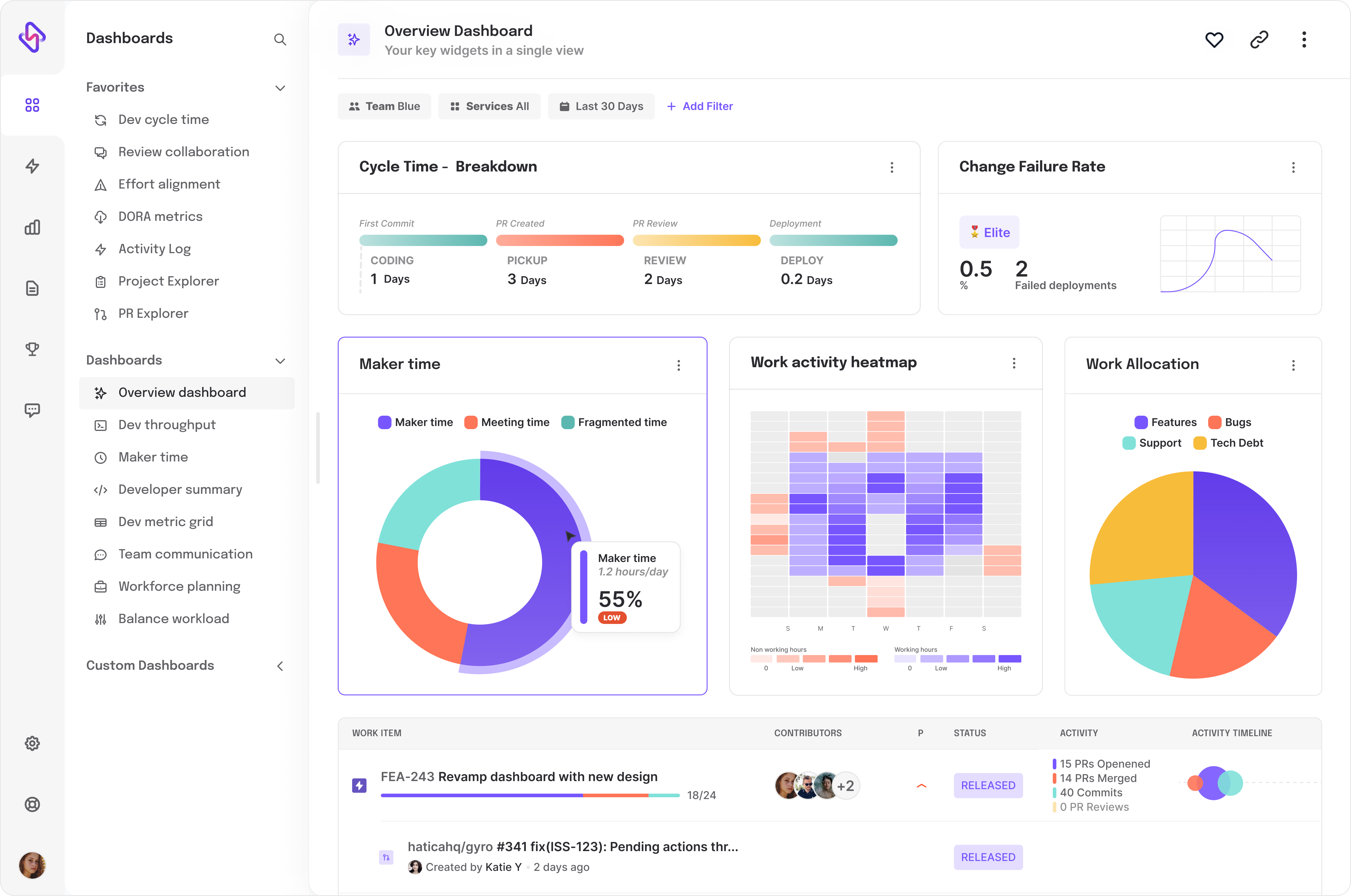For example, consider a scenario where a development team is tasked with implementing a new feature. The cycle time would include all stages, from coding and testing to review and deployment.
What is Lead Time?
Lead time takes a step back and looks at the bigger picture. It encompasses the entire duration from when a request is made until it is completed. This metric is broader than cycle time and includes all phases of a task's lifecycle, from the initial request to its final delivery. In software development, lead time provides a comprehensive view of how long it takes for a team to respond to customer demands and deliver a finished product.
Imagine a customer requests a new feature, and the engineering team takes it through analysis, design, development, testing, and deployment.
The lead time would cover the entire journey, reflecting the team's ability to meet customer expectations and deliver quality outcomes promptly.
Now let’s get into where they differ significantly!
What are the Key Differences Between Cycle Time and Lead Time?
Cycle time refers to the duration it takes for a team to produce a product, whereas lead time tracks the period from when a customer places an order to when that order is fulfilled.
While both cycle time and lead time are essential metrics, they serve different purposes and offer unique insights into the development process. Cycle time focuses on the efficiency of executing tasks, whereas lead time provides a broader perspective on overall responsiveness.
Here’s a simple way to remember it: cycle time is about how quickly your team gets things done internally, and lead time is about how quickly you can meet external demands.
Scope
Cycle time is all about what's happening inside the team. It's concerned with the internal workings of a team, measuring the time taken to complete specific tasks. Think of it as the pulse of your team’s day-to-day activities.
On the other hand, lead time considers the entire process, from the moment a customer makes a request to the point of delivery. It offers a more comprehensive view of the team's performance and how quickly they can turn a request into a reality.
Focus
Cycle time emphasizes process efficiency, helping teams identify bottlenecks and improve workflows. If you're looking to make things run smoother within the team, cycle time is your go-to metric. It's all about figuring out how to get tasks done faster and more efficiently.
Lead time is all about the customer. It focuses on customer satisfaction and the team's ability to meet external demands promptly. It's a reflection of how well your team is keeping up with customer expectations and delivering results when they matter most.
Application
Cycle time is often used to assess the speed of development teams and optimize internal processes. It’s perfect for pinpointing inefficiencies and figuring out how to make your team work most efficiently.
Lead time, meanwhile, is valuable for understanding customer-facing processes and ensuring timely delivery of features or products. If you're aiming to improve customer satisfaction and deliver faster, lead time is the metric that will guide your efforts.
Understanding these differences allows engineering leaders to leverage both metrics effectively, depending on their goals and priorities.
Now let’s get into how you can measure both of these metrics the right way!
How to Measure Lead Time vs. Cycle Time?
Cycle time is all about understanding the time it takes to complete one cycle of a process or task. In software development, this often refers to the time from when work begins on a task to when it is completed. Here's a simple way to calculate cycle time:
The general formula to calculate cycle time is
Cycle Time = Total Production Time / Total Number of Cycles
Example:
Imagine your engineering team completed ten user stories in a two-week sprint, with a total of 80 hours spent on development. The cycle time calculation tells you that, on average, each user story took 8 hours to complete.
Lead time is a bit more complex to measure, as it encompasses the entire process from the initial request to the final delivery. Unlike cycle time, lead time includes the waiting period before a task is started, which can vary significantly between different tickets. Some tickets may linger in the backlog for extended periods, while others are processed quickly. Including all tickets in lead time calculations can lead to inaccuracies and inflated metrics. Different teams or projects may have varying workflows, making it difficult to apply a one-size-fits-all approach to lead time measurement!
Ultimately, lead time and cycle time are values representing the relationship between effort and output. After all, not all effort results in progress, and not all output leads to the outcomes you’re looking for.
These metrics beg the question: What does it really take to create this product? And what does it take to create this product once our team makes it? What about our customer orders—do those match up with our fulfillment plans?
When properly monitored and measured, these values create an accurate picture of how an engineering team uses its time.
These metrics help establish realistic benchmarks, but what measures can you take to actually improve them, well, we cover this in the next section of the blog.
What Are the Steps You Can Take to Improve Cycle Time and Lead Time?
Improving cycle time and lead time can make a significant difference in how effectively your engineering team delivers value.
Here are some practical steps to help you get started:
1. Measure and Monitor
The first significant leap you can take is deciding to measure and monitor your metrics against industry benchmarks. Tracking these metrics helps you see where your engineering team stood a couple of sprints ago and where it stands now. By understanding your progress, you can make informed decisions about where improvements are needed.
Since cycle time is a subset of lead time, reducing your cycle time means you're also trimming down your lead time—or at least a pretty significant part of it. Regular monitoring allows you to spot trends and adjust your strategies accordingly.
2. Break Down Tasks into Smaller Chunks
One of the biggest reasons developers get bogged down with coding is because they try to tackle too much at once. Instead of taking on massive tasks, break them into smaller, more manageable pieces. This means creating smaller pull requests (PRs) that are tightly focused rather than one large PR filled with numerous changes.
- Why Smaller PRs Are Better: Smaller PRs get reviewed faster and often lead to higher-quality code. Because they're easier to digest, they're less likely to introduce bugs, and developers are more willing to merge them quickly.
- Aim for Precision: When tasks are precisely scoped, developers can focus on specific objectives, which leads to more efficient and effective work. This way, everyone knows exactly what needs to be done, and progress becomes smoother and faster.
3. Align Business Goals with Engineering Expectations
Often, there's a disconnect between what the business wants to achieve and what the engineering team is working on. Therefore, a crucial step in optimizing cycle time and lead time is aligning your engineering team's efforts with your broader business goals. This alignment ensures that your team is not just building features or fixing bugs but is actively
By bridging this gap, you ensure that every line of code written is purposeful and directly tied to business success.
For example, if the business goal is to improve customer satisfaction, the engineering team might focus on reducing bugs and improving user interface features that directly enhance the user experience. Establishing Key Performance Indicators (KPIs) that link engineering tasks to business outcomes keeps everyone focused on the bigger picture.
Leveraging engineering management platforms like Hatica can provide invaluable insights into your development process. Such platforms can highlight areas where work is getting stuck, enabling you to address issues before they become significant obstacles.
With clear visualizations, you can track tasks from start to finish and see where delays are occurring, giving you the data you need to make informed decisions.
Implementing these steps not only helps you satisfy both lead time and cycle time metrics but also provides your engineering team with a solid benchmark. This benchmark serves as a reference point for each sprint or quarter and overall improves the efficiency of the entire engineering team!
Making the Most of Cycle Time and Lead Time in Software Development
Although cycle time and lead time originated in manufacturing, they offer valuable insights for software engineering teams. When combined, these metrics give you a complete view of your development cycle. Cycle time helps you see how efficiently your team completes tasks, ensuring everything runs smoothly. Lead time, on the other hand, provides the big picture—from the time a customer request is made to the final delivery back to the customer.
By improving both cycle time and lead time, you can find a balance where your engineering team excels. This alignment helps you meet both your engineering goals and business objectives.
If you need help getting started, our productivity experts are here to guide you every step of the way. Reach out to them today!




